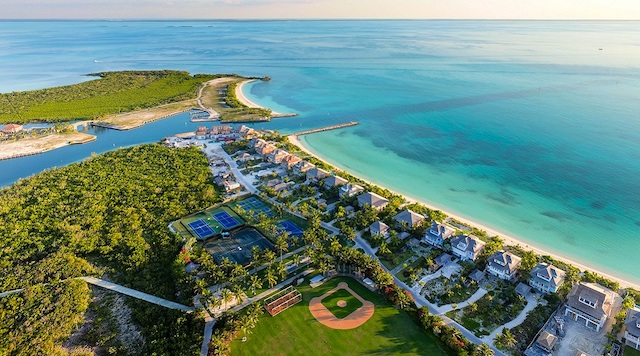 The billions of dollars in development projects slated for the Bahamas could devastate our natural environment if we are not careful, experts say.
The billions of dollars in development projects slated for the Bahamas could devastate our natural environment if we are not careful, experts say.
Tourism is the world’s biggest industry, and we are just off the coast of a huge, affluent market. Our relative safety, low population density and outstanding physical amenities, makes the Bahamas a prized destination.
As one Internet message board posting put it, “Winding Bay on (Abaco) is sold out. Emerald Bay (in Exuma) is sold out. Everybody wants to be in the Islands of the Bahamas. All the Sunday travel sections are regaling these developments. The Bahamas is HOT, HOT, HOT.”
Multi-million-dollar projects like these represent our national development strategy . In fact, the policy of siting “anchor” developments on major islands dates back to the Pindling era, (when the Family Island Master Plan was drafted) and was hotly pursued by the Ingraham administration.
Like a major tenant that helps carry a retail property, the idea is for investors to build residential/resort complexes that will provide infrastructure for local communities and spur economic growth. These projects are thought to make the most profitable use of our limited resources.
Meanwhile, the North American demand for vacation homes in convenient waterfront areas is rising dramatically, and most Bahamian islands are still underdeveloped. Abaco is a leading example – already, more visitors to that island stay in second homes than in hotels.
Dave Ralph of the Abaconian newspaper in Marsh Harbour, says the secondary benefits of residential tourism are just as lucrative as traditional hotel tourism. Rental boats, golf carts, restaurants and many other local businesses rely on servicing second homers.
“Abaco’s native population of 13,000 is served by five commercial banks in Marsh Harbour,” he points out. “(That population) cannot support five banks. It is the relatively high tourism activity and our substantial base of second home owners that support these banks. Rental houses have allowed small settlements to participate in the tourism boom without the benefit of a hotel.”
Like hotel guests, most second homers prefer the coast – the most fragile part of the environment in an island nation like ours. In fact, scientists view the entire Bahamas as a coastal zone, with familiar features like coral reefs, mangrove wetlands, beaches, and sea grass beds that are important for local fisheries as well as foreign tourism.
But it is becoming increasingly clear to policymakers around the world that national development goals cannot be met without good environmental protection. The world’s natural resources are under severe pressure from poorly planned, uncontrolled, and in some cases, difficult-to-sustain development.
In the Caribbean,for example, tourism expansion has led to deforestation, beach loss, lagoon pollution and reef damage from dredging, boat anchoring and improper waste disposal by hotels, cruise ships and yachts. These are the very assets that attract tourists in the first place. As a result, experts are calling for greener, lower-density tourism styles.
In the Bahamas, decisions on land development are made in a vacuum. And the government often has no real understanding of the carrying capacity of either the infrastructure or the environment. Outdated land administration procedures are inefficiently split between a variety of government agencies.
And since the government controls 70 per cent of our real estate and must vet all investment projects – this is an important issue. In fact, some $5 million has recently been allocated to come up with an integrated land use policy to help the Bahamas tackle these problems.
According to the Inter-American Development Bank (which is providing most of the cash), such a policy “will ensure a pattern of growth and use of land that supports development while addressing sustainability issues and environmental concerns.”
That’s because the existing framework was not designed to cope with the level of development pressure the country now faces. And the pressure derives from a development strategy pursued by both the present and former government, despite Hubert Ingraham’s hairsplitting remarks during the recent budget debate.
Chief among the planning deficiencies is the lack of zoning outside of New Providence and Grand Bahama. Planning regulations in Nassau are hardly enforced anyway, and Family Island communities have little say in the decision-making process. To cap it all off, there is no computerised geographic information system to bring land use planning and development monitoring into the modern age.
In addition to the IDB’s land administration upgrade project, studies are underway on how to protect coastal zones from careless – and often unnecessary – destruction. One of these is a five-year project on coastal ecology in the Bahamas supported by the Earthwatch Institute, which began in 2002.
Earthwatch engages volunteers in field research and education around the world “to promote the understanding and action necessary for a sustainable environment.” Currently, it supports more than 140 expeditions in 48 countries.
The Bahamas research is looking at the effects of coastline development on land and sea environments by comparing satellite data to on-the-ground information. The objective is to quantify development impacts and find ways to protect and restore coastal ecosystems.
The Earthwatch team has already surveyed coasts on Andros, Eleuthera and Exuma, and are now moving to Abaco. The project is led by marine biologist Dr Kathleen Sullivan Sealey, who recently became Dean of the Faculty of Pure and Applied Sciences at the College of the Bahamas. Married to a Bahamian, she is on secondment from the University of Miami.
“Tropical islands present a particular challenge in balancing development needs and environmental protection,” she told Tough Call recently. “We are working on a ranking system for human impacts on Bahamian coastlines that will guide development planning and national park placement.”
A lot of the Abaco fieldwork is being conducted at Great Guana Cay, where a 585-acre development called Baker’s Bay Golf & Ocean Club has aroused much controversy lately. In her capacity as a biology professor at the university of Miami, Dr Sullivan Sealey produced the 140-page environmental impact assessment of the project for the BEST Commission recently.
Although the EIA costs are underwritten by the developer – in this case, the Discovery Land Company of San Francisco – the report was researched and written under an arm’s length grant to the university, which is solely responsible for its content. University researchers are also setting up a monitoring programme for the development to see that environmental guidelines are followed.
This programme will be implemented through the Great Guana Cay Foundation – a non-profit partnership between the developers and both the University of Miami and the College of the Bahamas. The foundation’s aim is to research and recommend sustainable development practices.
“The research team has developed guidelines to maintain the biodiversity and environmental integrity of the property and nearshore marine environment throughout the development process,” Dr Sullivan Sealey said. “We will observe the development progress and submit regular reports to the BEST Commission that will compare field research to pre-development data and offer solutions to any problems that may arise.”
The foundation will also manage the island’s 66-acre heritage preserve and special conservation areas – including mangrove wetlands, dune systems and shoreline buffer zones. Its most important role is to facilitate a dialogue between developers and scientists on ways to promote environmental sustainability, particularly on small islands like Guana Cay.
As part of this dialogue the foundation will create a living history of Guana Cay, maintaining a dynamic information system on the island’s ecology and physical environment before, during and after development of the Baker’s Bay community – which occupies about half of the 1100-acre cay.
According to Dr Livingstone Marshall, the prime minister’s former science advisor who was recently put in charge of environmental and community affairs at the Baker’s Bay development, the project’s environmental team is” the largest single in-house gathering of experts ever assembled on a long-term basis for any development project in the Bahamas.”
In a recent talk, he pointed out that the project design would “preserve the island’s natural vistas, retain a shoreline buffer in its natural state, restore damaged coastal areas, prohibit private docks and maintain public beach access.
“Houses will not be obvious, and shaded paths and boardwalks along the coast will protect wildlife habitat as well as maintain coastal stability. Natural coppice and wetlands will be incorporated into the development and landscaping will rely on native plants and seed stock combined with the preservation of mature trees. Undoubtedly, Baker’s Bay will serve as a model by which all future projects can be assessed and guided.”
In addition to development spending, the Baker’s Bay project is expected to turn over a billion dollars in real estate sales during the next several years. Bahamian realtors will earn commissions on these transactions and the government will tax them. And the wealthy second homers who come to buy are expected to pump huge amounts of cash into the Abaco economy.
The project includes 450 private homes, a 75-room luxury hotel, a 180-slip marina with a port village, and an 18-hole golf course. More than half of the land will remain open space, and the developers have gone to great lengths to follow sound environmental advice. The Joe’s Creek wetland is being folded into the public access preserve and a five-acre public beach park is being set aside on the Sea of Abaco.
All of these facilities are served by a central sewerage and solid waste system that will be open to the entire island, as well as a water purification and recycling plant. The developers will also build a community centre and provide fire-fighting facilities for the island as a whole.
All things considered, it is a remarkable package.
And we should not overlook the fact that Guana Cay – like other islands in the Bahamas – has been undergoing an unplanned transformation for many years. The Baker’s Bay property was acquired from Ludwig Meister – a naturalised Bahamian who also operates the Treasure Cay Club. Meister was responsible for the cruise ship channel and shore facility built by Premier Cruise Lines in 1989 under license from Disney.
When the 90-acre shore facility closed in 1993, it was simply abandoned – leaving derelict buildings, dump sites, and hazardous materials. Nearby reefs were degraded by dredging and debris from the dock and dolphin pen. And invasive plants were introduced that out-compete the native vegetation.
So the Baker’s Bay developers have launched a milion-dollar remediation programme. Contaminated soil and arsenic-treated lumber, storage tanks and electrical transformers are being removed, along with invasive plants and trees. The nearshore environment will be cleaned up and corals are being transplanted on artificial patch reefs to replace those that were smothered by the cruise ship dredging.
And we must also accept that there are other developments on the island that follow no particular environmental guidelines, have no central waste disposal facilities, are unconcerned about invasive plants, allow multiple docks along the shore, and don’t observe proper coastal setbacks.
The Guana Cay controversy highlights the key development issues for small island states like the Bahamas. How do you decide what level of development is appropriate? And how do you control and minimise the negative impact on the environment while maximising the economic benefits?
The government has been edging towards answering these questions ever since the BEST Commission was created in 1994. A national environmental policy has been put forward for public discussion. And BEST will soon be upgraded into a full-fledged Department of the Environment.
A raft of facilitating legislation has been circulated recently– including EIA regulations, pollution controls, and rules to make private, non-governmental organisations more accountable.
But however you look at it, change is inevitable. And pressure from environmentalists and concerned citizens has led to significant improvements in the way we handle such development proposals.
This is a good thing. And our goal must be to manage development intelligently. That requires a national consensus on up-front policies that make all such projects fully accountable.
The views expressed are those of the author, and not necessarily those of the Nassau Institute (which has no corporate view), or its Advisers or Directors.
This article was first published in The Tribune on Wednesday, June 22, 2005.
The column ‘Tough Call’ by Larry Smith is published in The Tribune every Wednesday and is reprinted here as a courtesy. Mr. Smith founded and successfully grew an advertising agency over 20 years. Under his direction Media Enterprises diversified into short-run commercial printing and publishing, and is now the largest non-fiction book wholesaler in the Bahamas. He has 30 years experience as a journalist and publicist and has contributed numerous articles and columns to the Bahamian press. A former reporter at the Nassau Guardian, local correspondent for Reuters and editor at the Bahamas News Bureau, he conceived and edited the Bahama Almanac (published 2000 by Media Enterprises), wrote the commentary for Mike Toogood’s Portrait of an Archipelago (published 2004 by Macmillan Caribbean), and edited the Bahamas Environmental Handbook (published 2002 by the government). In 2003 he took a year’s leave of absence from Media Enterprises to lead a transition management team at the Nassau Guardian after the paper was acquired by local investors. After leaving the Guardian he was contracted by the Tribune as online manager/editor and columnist. He has a degree in political science and journalism from the University of Miami.


